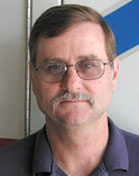Chief Clinical Consultant for
Emergency Medicine

James G. Flaherty, MS, MD, FAAP
EMS Medical Director
Emergency Department, TCRHCC
PO Box 600
Tuba City, AZ 86045-0600
(928) 283-2406 (messages)
(928) 273-3025 (cell)
Jim Flaherty, MS, MD, FAAP, has spent his career in the Navajo Area. He is presently a staff physician in the Emergency Department at the Tuba City Regional Health Care Corporation in Tuba City, Arizona. He has practiced rural emergency medicine and been an EMS medical director for the past twenty years. His special interests include emergency medical services systems, trauma system development, pediatric resuscitation and stabilization, toxicology, and injury prevention. He completed his residency in pediatrics and fellowship in pediatric emergency medicine at Oakland Children’s Hospital in northern California.
More about Jim Flaherty
Jim has participated in a wide variety of activities related to emergency medicine and EMS. He is Fellow of the American Academy of Pediatrics, and a member of the Committee on Pediatric Emergency Medicine (COPEM), and PALS Regional Faculty for the Arizona American Heart Association. He serves as the Medical Director for Navajo Emergency Medical Services, the largest tribal EMS system. He was liaison for all tribal and IHS EMS programs through an inter-agency agreement with HRSA’s Emergency Medical Services for Children (EMSC) Program of the Maternal and Child Health Bureau. As a member of the Intermountain EMSC Coordinating Council (IRECC), he was active in promoting EMSC goals, activities and education locally and nationally for the IHS. He is an active member of the National Association of EMS Physicians (NAEMSP), and the National Native American EMS Association (NNAEMSA). He has contributed to the publication of EMS system assessments for Navajo, Albuquerque, and Phoenix Area Offices, and edited an assessment of the Unmet Need in Tribal and IHS EMS. He was on the editorial board of the Office of Rural Health Policy’s Rural and Frontier EMS Agenda for the Future, and a member of the American College of Surgeon’s technical team for the Wyoming Trauma System Consultation. He recently served on the Arizona Department of Health Services State Trauma Advisory Board, and is presently working with the Navajo Division of Health on the development of a trauma system for the Navajo Nation.
Links of Interest
Dr. David Boyd, IHS Trauma Services
Dr. Jim Upchurch, EMS Medical Direction
Emergency Medicine
- American College of Emergency Physicians (ACEP)

- American
Academy of Emergency Medicine (AAEM)

- Society of Academic Emergency Medicine
(SAEM)

- American Academy of Pediatrics
(AAP), Committee on Pediatric Emergency Medicine (COPEM)

- Center for Medicare and Medicaid Services, EMTALA

Emergency Medical Services ( EMS)
- National Highway Traffic Safety Administration, Office of EMS

- Emergency Medical Services for Children (EMSC) Program

- National Association of EMS Physicians (NAEMSP)

- Mountain Plains Health Consortium (MPHC)
 The IHS EMS Black Hills training center moved from Rapid City to Sturgis,
SD, in 1997, and was incorporated into the MPHC. The EMS training staff provides
primary and continuing EMS education to tribal EMS and CHR programs in Sturgis
and on-site at tribal EMS programs. MPHC maintains a current contact list of
all tribal EMS programs. It is supported by funding from IHS HQE and Aberdeen
Area, through an inter-agency agreement with the VA.
The IHS EMS Black Hills training center moved from Rapid City to Sturgis,
SD, in 1997, and was incorporated into the MPHC. The EMS training staff provides
primary and continuing EMS education to tribal EMS and CHR programs in Sturgis
and on-site at tribal EMS programs. MPHC maintains a current contact list of
all tribal EMS programs. It is supported by funding from IHS HQE and Aberdeen
Area, through an inter-agency agreement with the VA.
- National Native American EMS Association (NNAEMSA)
 The Board of the NNAEMSA provides national tribal EMS leadership, and the
organization hosts a week-long annual educational meeting for tribal EMS programs.
The website for NNAEMSA is maintained at MPHC.
The Board of the NNAEMSA provides national tribal EMS leadership, and the
organization hosts a week-long annual educational meeting for tribal EMS programs.
The website for NNAEMSA is maintained at MPHC.
Emergency Preparedness and Management
Injury Prevention
Trauma
- American College of Surgeons(ACS)
Committee on Trauma (COT)

- American
College of Surgeons (ACS), Rural Trauma Team Development Course

- National
Trauma Data Bank ®

- Journal of Trauma, Injury, Critical Care, and Infection

- Journal of ACS

IHS Trauma Services
 Dr David R. Boyd, MDCM, FACS is a General Surgeon with 23 years experience
in the US Public Health Service (PHS). The last 12 in the Indian Health Service
(IHS), he was the staff surgeon at the Blackfeet Community Hospital in Browning,
MT.
Dr David R. Boyd, MDCM, FACS is a General Surgeon with 23 years experience
in the US Public Health Service (PHS). The last 12 in the Indian Health Service
(IHS), he was the staff surgeon at the Blackfeet Community Hospital in Browning,
MT.
Dr Boyd comes from Seattle, WA, where he went to public school and was active in many sports. He graduated from Central Washington College of Education in Ellensburg, WA, with a Bachelors of Arts and Science in 1958. His combined majors were Psychology and Pre-medicine. His medical education is from McGill University in Montreal, PQ, Canada, graduating MDCM in 1963.
Dr Boyd did a rotating internship at the Cook County Hospital (CCH) in Chicago, IL. He was drafted into the US Army, serving as Captain in the Medical Corps from 1964-66. He returned to surgical training at the University of Maryland and was a “Shock-Trauma Fellow” at the developing Maryland Institute for Emergency Medical Services Systems (MIEMSS). He returned to the CCH surgery program and became the “Resident Director” of our nation’s first civilian Trauma Unit (TU). He established the first “Computerized Trauma Registry” under an NIH grant. He wrote the plan and later implemented the Illinois Statewide Trauma and Emergency Medical Services System from 1971-74.
He was also the Illinois State Medical Disaster Officer and initiated a more rational and coordinated disaster response system, utilizing the designated Trauma Centers and their Trauma/EMSS Coordinators as lead personnel. evaluate the problem, and initiate the appropriate medical and hospital response, activate the transportation and communication components, and coordinate with environmental health, and other agencies, including Civil Defense. He designed and implemented an effective Trauma and Emergency Medical Guidelines and EMS Operating Component Standards statewide. Many became national standards later.
In 1972 he testified before the US Congress on the need for a National EMS System. He wrote the clinically relevant parts of PL 93-154, “The EMS Systems Act of 1973”. He was appointed National Director of the Office of EMSS in PHS, DHEW and later DHHS. In this capacity he worked with public and private sectors, state, territorial, local and tribal governments, health and safety, professional, public advocacy and political interests in Trauma and EMSS. He established the “303” EMSS Contiguous Geographic Regions and defined the National Trauma and EMS program. He worked closely with IHS and the initial EMSS program.
Dr Boyd left the Federal Government in 1983 and established a private EMSS consulting firm working with domestic and international clients. He returned to clinical work in emergency medicine in 1991. He was the general surgeon at the Blackfeet Community Hospital in Browning, MT since 1993 and Clinical Director (CD) there in 2002-03. He is currently the National Trauma Systems Coordinator in the Office of Emergency Services (ES), Indian Health Service (IHS) Rockville, MD. He is the IHS representative to the Federal Inter Agency Committee for Emergency Medical Services (FICEMS)
DR Boyd has published over 110 scientific articles on Trauma, Shock and Trauma/EMS Systems including a textbook on EMS. He has received many honors including the “Distinguished Career Award” from the American Public Health Association (APHA), Injury Control and Emergency Medical Services Section in 1998 and the National Safety Council (NSC) Surgeons’ Award for Service to Safety and the Journal of EMS Physio Control “Living Legends of EMS Award” in 2006.
He has implemented the IHS Alcohol Screening/ Behavior Intervention (ASBI) Program and is developing the Director’s Trauma Initiative.
Dr Boyd is married to Joyce M. Boyd MDCM, FAAP. They have four adult children and four grand children.
Contact Dr. David Boyd at the Office of Emergency Services at Rockville, Maryland: 301-443-1557
EMS Medical Direction
 Jim Upchurch MD, MA, NREMTP practices in Montana and is board certified in
Family Practice with added qualification in Geriatrics. He has a master’s
degree in education and human development and is licensed as a paramedic. Dr.
Upchurch is a ‘Legacy’ member of the American College of Emergency
Physicians. Since 1985 his practice has been with the Indian Health Service and
has focused on emergency medicine and EMS while providing the full spectrum of
care required in a rural/frontier environment. He provides medical direction
for BLS and ALS EMS systems, including a critical care interfacility transport
service. He also provides medical direction for the Incident Medical Specialist
Program, USDA Forest Service, Northern Region and the Northern Rockies Smokejumper
Program. Dr. Upchurch has served as American Heart Association ACLS Regional
and National faculty for Montana and currently represents Montana on the Council
of State EMS Medical Directors of the National Association of State EMS Officials.
Jim Upchurch MD, MA, NREMTP practices in Montana and is board certified in
Family Practice with added qualification in Geriatrics. He has a master’s
degree in education and human development and is licensed as a paramedic. Dr.
Upchurch is a ‘Legacy’ member of the American College of Emergency
Physicians. Since 1985 his practice has been with the Indian Health Service and
has focused on emergency medicine and EMS while providing the full spectrum of
care required in a rural/frontier environment. He provides medical direction
for BLS and ALS EMS systems, including a critical care interfacility transport
service. He also provides medical direction for the Incident Medical Specialist
Program, USDA Forest Service, Northern Region and the Northern Rockies Smokejumper
Program. Dr. Upchurch has served as American Heart Association ACLS Regional
and National faculty for Montana and currently represents Montana on the Council
of State EMS Medical Directors of the National Association of State EMS Officials.
Contact Dr. Jim Upchurch in Crow Agency, Montana. With NAEMSP and the Critical Illness and Trauma Foundation, he has developed a web-based core content educational module for new rural EMS medical directors, a Guide for Preparing Medical Directors.

